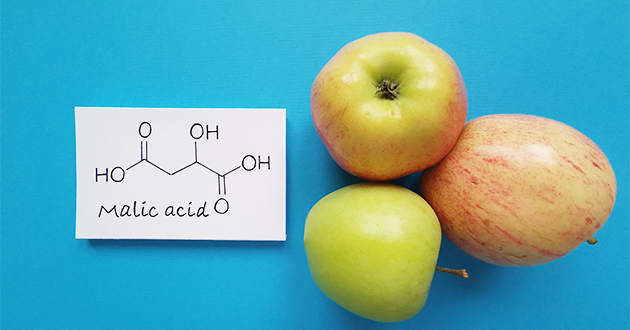[Alpha Hydroxy Acid AHA] Exfoliation: The Key to Radiant Skin
[Alpha Hydroxy Acid AHA] Exfoliation: The Key to Radiant Skin
Exfoliating is essential for unveiling radiant skin, and this can be effectively achieved using alpha hydroxy acid (AHA) to remove old keratin and regulate skin turnover.
Table of Contents
Structure of the skin
The skin consists of three primary layers: the epidermis, dermis, and subcutaneous tissue. The epidermis itself has five distinct layers, each playing a vital role in skin health. The basal layer, located at the bottom of the epidermis, is where new cells are generated. These cells move upwards, replacing older cells, and eventually shed as dead skin. This natural process, known as skin turnover, usually takes between 28 to 40 days but can slow down due to aging or lifestyle factors, leading to the accumulation of old keratin.
This metabolic mechanism that occurs within the epidermis is called turnover. The average of turnover cycle is 28 to 40 days, but aging and lifestyle disorders can delay turnover, creating a situation in which old keratins tend to accumulate.
Understanding Alpha Hydroxy Acid (AHA)?
Alpha hydroxy acid, commonly found in esthetic treatments, is a natural organic acid derived from fruits, sugar cane, and milk. It is often referred to as fruit acid or AHA. The most commonly used AHAs in dermatology include glycolic acid (from sugarcane), citric acid (from citrus fruits), lactic acid (from sour milk), malic acid (from apples), and tartaric acid (from grapes).

The Benefits of AHA
Gentle exfoliation
AHAs effectively loosen the bonds between cells in the stratum corneum, facilitating gentle removal of dead skin cells without the harshness of physical scrubs.
Brightening Effect
AHAs reveal a fresher, brighter layer of skin by removing old keratin.
Promotes collagen production
Collagen plays a pivotal role in maintaining the skin's firmness and elasticity. However, factors like aging and exposure to UV light gradually diminish collagen levels, leading to the development of wrinkles and sagging skin. Research involving glycolic acid, a type of AHA, reveals its capacity to stimulate fibroblasts — the cells responsible for collagen production — thereby boosting collagen synthesis. Additionally, glycolic acid has been shown to enhance the genetic expression of collagen and hyaluronic acid, further supporting skin health and resilience.
Reducing of Fine Lines and Wrinkles
AHAs have been shown to effectively minimize fine lines and wrinkles. In a study with 52 volunteers, using an AHA-infused anti-aging skincare product with vitamins B3, C, and E for three weeks significantly improved wrinkle depth and skin texture.
Pigmentation Reduction
Regular use of AHAs can improve pigmentation issues by promoting normal skin turnover.
Acne control

Acne arises from the clogging of pores due to an excess of keratin, sebum, and bacteria. The exfoliating properties of AHAs help to clear these blockages and restore normal skin turnover, potentially diminishing acne scars over time.
A comprehensive study with 248 participants suffering from various types of mild acne (comedonal, inflammatory, and mixed) demonstrated significant improvement with the use of AHA-based creams. Participants applied the cream twice daily for 60 days, finding it both effective and well-tolerated in managing acne symptoms.
Boosts the Effectiveness of Skincare Regimens
Accumulated old keratin acts as a barrier, preventing daily skincare products like lotions, serums, and moisturizers from penetrating beyond the skin's surface. By effectively removing this layer of dead keratin, AHA enhances the absorption and efficacy of these products, ensuring they reach the deeper layers of the skin for optimal results.
Another Hydroxy Acid: BHA
Beta hydroxy acid (BHA) is another effective component for skin care. Unlike the water-soluble AHA, BHA is fat-soluble, making it particularly effective in penetrating pores and treating acne and blackheads.
Tips for Effective AHA Use
Important Safety Guidelines
Reference: Treasure Island (FL): StatPearls Publishing; 2021 Jan-. Med Hypotheses . 1999 Nov;53(5):380-2. doi: 10.1054/mehy.1998.0788. Clin Cosmet Investig Dermatol . 2014 Dec 19;8:9-17. doi: 10.2147/CCID.S75439. eCollection 2015. Dermatol Surg . 2001 May;27(5):429-33. doi: 10.1046/j.1524-4725.2001.00234.x. J Dermatol . 1998 Feb;25(2):85-9. Clin Cosmet Investig Dermatol . 2014 Dec 19;8:9-17. doi: 10.2147/CCID.S75439. eCollection 2015. G Ital Dermatol Venereol . 2010 Jun;145(3):319-22.
* These statements have not been evaluated by the Food and Drug Administration. This product is not intended to diagnose, treat, cure, or prevent any disease.

 US Dollar
US Dollar
![[Alpha Hydroxy Acid AHA] Exfoliation: The Key to Radiant Skin [Alpha Hydroxy Acid AHA] Exfoliation: The Key to Radiant Skin](https://cdn11.bigcommerce.com/s-8m5bvhnag1/images/stencil/500x659/uploaded_images/naturopathystoreblog-.png?t=1701410061)
